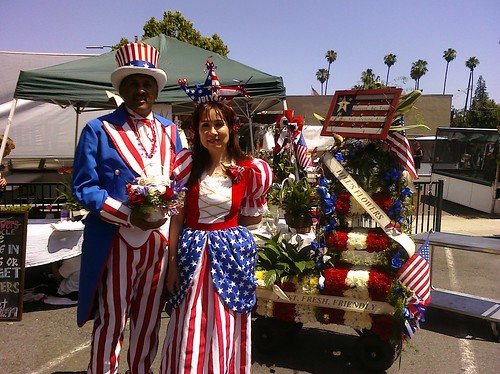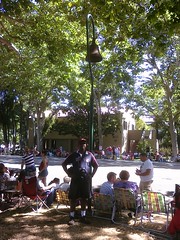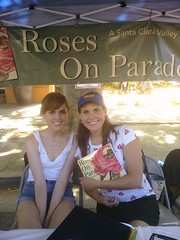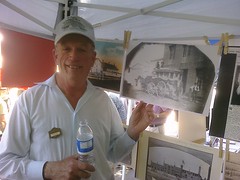 Every year I think I’ve written new Fourth of July traditions in stone. I let myself believe I’ve got the celebration dialed in, and that’s the way I’ll be observing it from then on. And every year I’m wrong. Something changes that causes a little tweak or a giant upheaval. Sometimes it’s an improvement, and sometimes it’s a back-to-the-drawing-board experience. For years though the cornerstone of our July 4 festivities was the America Festival at Downtown San Jose’s Discovery Meadow. Sadly in 2009 that mighty event fell victim to the deflated economy and had to be canceled. To console ourselves on the Fourth our family went to Calvin’s on The Alameda for cheese steaks and discovered quite by accident the Rose, White, and Blue Parade. We missed the morning parade but the accompanying festival was still on so we perused the booths and shops, and made plans to come back this year.
Every year I think I’ve written new Fourth of July traditions in stone. I let myself believe I’ve got the celebration dialed in, and that’s the way I’ll be observing it from then on. And every year I’m wrong. Something changes that causes a little tweak or a giant upheaval. Sometimes it’s an improvement, and sometimes it’s a back-to-the-drawing-board experience. For years though the cornerstone of our July 4 festivities was the America Festival at Downtown San Jose’s Discovery Meadow. Sadly in 2009 that mighty event fell victim to the deflated economy and had to be canceled. To console ourselves on the Fourth our family went to Calvin’s on The Alameda for cheese steaks and discovered quite by accident the Rose, White, and Blue Parade. We missed the morning parade but the accompanying festival was still on so we perused the booths and shops, and made plans to come back this year.
 We arrived early this year and found shady spots on the parade route, under the El Camino bell on the west side of The Alameda at Singletary. That was no accident; it’s a special spot for me. I’m generally not a parade person because they’re always too early in the morning (I like to sleep in on holidays; so sue me), but I was in the right mood and this one was delightful. It’s not a huge production with marching bands and animatronic floats. Rather it’s a heartfelt community showcase with neighborhood kids on bikes, girl scout and boy scout troops, vintage car enthusiasts, and elected officials. The geeky highlight was Grand Marshal Steve Wozniak riding an Egyptian barque, surrounded by his Segway polo friends, one of whom was coincidentally an old co-worker of mine from Apple, Bill Knott. The giggliest moment was a lone be-kilted bagpipe player droning out Rod Stewart’s “Da’ Ya’ Think I’m Sexy.” The most sublimely surreal moment was Chuck Reed, the mayor of San Jose, cruising down The Alameda in the back of a straight-up cherry low-rider, bewildering uninitiated onlookers every time it stopped and dropped so low it was scrapin’.
We arrived early this year and found shady spots on the parade route, under the El Camino bell on the west side of The Alameda at Singletary. That was no accident; it’s a special spot for me. I’m generally not a parade person because they’re always too early in the morning (I like to sleep in on holidays; so sue me), but I was in the right mood and this one was delightful. It’s not a huge production with marching bands and animatronic floats. Rather it’s a heartfelt community showcase with neighborhood kids on bikes, girl scout and boy scout troops, vintage car enthusiasts, and elected officials. The geeky highlight was Grand Marshal Steve Wozniak riding an Egyptian barque, surrounded by his Segway polo friends, one of whom was coincidentally an old co-worker of mine from Apple, Bill Knott. The giggliest moment was a lone be-kilted bagpipe player droning out Rod Stewart’s “Da’ Ya’ Think I’m Sexy.” The most sublimely surreal moment was Chuck Reed, the mayor of San Jose, cruising down The Alameda in the back of a straight-up cherry low-rider, bewildering uninitiated onlookers every time it stopped and dropped so low it was scrapin’.
By the time the last of the parade passed bytwo ladies on horseback (it was smart to put them last) with a police car chaserit was lunchtime so we headed once again to Calvin’s. Tradition! I can think of no better tribute to the signing of the Declaration of Independence than Philadelphia’s best cheese steaks. We weren’t alone; the line was out the door. It was an extra long wait but so worth it, and we reveled in our “sandmiches” while an Elvis impersonator cheesed us from the “American Stage.” Then we worked our way down the double row of boothsnearly twice as many as last yearcleverly arranged on the shady western half of The Alameda between Lenzen and Race. Kudos to the prior and current presidents of The Alameda Business Association Larry Clark and Michael Barnaba for spearheading a successful and growing event. My wife was drawn to the vendors of handmade jewelry, but I had a different agenda.
Two agendas, actually. The first was chocolate. Schurra’s had a booth and I bought myself a Rocky Road treat: a giant homemade marshmallow brick topped with almonds and covered in chocolate. The lady asked if I wanted a bag. Ha! I told her that would only slow me down. It was gooey, melty wonderment.
 That out of the way, I moved on to my primary objective. This was the third year for the Rose, White, and Blue Parade, but it traces it roots back to a legacy of Rose Festivals in San Jose dating back to 1896. At the 2009 parade I found Shannon Clark’s book, The Alameda: the Beautiful Way, which I acknowledge was the spark that convinced me finally to start this All Camino blog. This year I was delighted to see she had produced a new book in collaboration with her sister Allison called Roses on Parade: a Santa Clara Valley Tradition, an exposition of this very event. I bought the book at their booth, got it signed, and networked with my fellow El Camino history buffs. At least I thought I was a history buff, until I met Bill.
That out of the way, I moved on to my primary objective. This was the third year for the Rose, White, and Blue Parade, but it traces it roots back to a legacy of Rose Festivals in San Jose dating back to 1896. At the 2009 parade I found Shannon Clark’s book, The Alameda: the Beautiful Way, which I acknowledge was the spark that convinced me finally to start this All Camino blog. This year I was delighted to see she had produced a new book in collaboration with her sister Allison called Roses on Parade: a Santa Clara Valley Tradition, an exposition of this very event. I bought the book at their booth, got it signed, and networked with my fellow El Camino history buffs. At least I thought I was a history buff, until I met Bill.
 The booth next to the Clark sisters’ was a modest affair, simply a few rows of clotheslines with historic photos of The Alameda clothes-pinned to them, flapping like pennants in the warm breeze. A lone gentleman was narrating them, jovially taking questions and leading listeners from photo to photo to illustrate the timelines he was reciting from memory. His name is Bill Wulf and he’s a 71-year-old San Jose native, railroad enthusiast, Los Gatos expert, and Santa Clara Valley historian extraordinaire. It’s tempting to say he knows everything there is to know about local history and his ready facility with names, dates, and anecdotes would seem to back up that claim, but it would do him a disservice. He impressed upon me that though he has been meticulously and doggedly researching his subject for decades, he’s still learning something new every day and constantly having his understanding challenged and refined. That’s what amazed me. He’s not just a passive font of facts; he’s an active and probing student of stories, and a really nice guy no less. He’s the kind of historian I can only aspire to be.
The booth next to the Clark sisters’ was a modest affair, simply a few rows of clotheslines with historic photos of The Alameda clothes-pinned to them, flapping like pennants in the warm breeze. A lone gentleman was narrating them, jovially taking questions and leading listeners from photo to photo to illustrate the timelines he was reciting from memory. His name is Bill Wulf and he’s a 71-year-old San Jose native, railroad enthusiast, Los Gatos expert, and Santa Clara Valley historian extraordinaire. It’s tempting to say he knows everything there is to know about local history and his ready facility with names, dates, and anecdotes would seem to back up that claim, but it would do him a disservice. He impressed upon me that though he has been meticulously and doggedly researching his subject for decades, he’s still learning something new every day and constantly having his understanding challenged and refined. That’s what amazed me. He’s not just a passive font of facts; he’s an active and probing student of stories, and a really nice guy no less. He’s the kind of historian I can only aspire to be.
I honestly have no idea how long I stood there talking to him, he was so generous with his time and information. I think it was a couple hours. I lost track of time and shamefully neglected my wife (she bought some jewelry in mock revenge), but I learned a ton of great things, like how Mrs. A.S.C. Forbes was inspired by her colorful father-in-low James Alexander Forbes to romanticize California’s Mission past and memorialize El Camino Real with posted bell markers. I learned about troves of primary sources to explore like forgotten county archives and collections of the Franciscan order. I appreciated his theories about practical land routes that were the basis of the real El Camino. And I only scratched the surface. I look forward to meeting him again.
Finally I tore myself away and my wife and I finished strolling the fair and went home. Our day wasn’t done though. You’d think we would have both had enough history for one day by then, but you underestimate our capacity. We grabbed a couple sandwiches from the Togo’s at Oakland Road and Brokaw and headed down to History Park in San Jose’s Kelley Park for the History San Jose Fourth of July Celebration. Can I possibly use the words “history” and “San Jose” any more in a single sentence?
If you had trouble parsing that sentence, it will help to know that “History San Jose” is the name of San Jose’s historical association. They host an annual members-only (yeah, I’m a member) Independence Day event at their showpiece village in Kelley Park, a collection of reconstructed or physically relocated buildings and landmarks from San Jose’s past. Kelley Park isn’t quite on El Camino Real (it’s three long blocks from Monterey Road) but its centerpiece is a half-scale replica of the famous electric light tower which once straddled the intersection of First and Santa Clara Streets downtown, so it represents. We rode the electric trolley and strolled the grounds and chatted with Judya long-time HSJ volunteer we metand her family and friends until it was dark enough to enjoy the San Jose Giants fireworks display happening across the street at Municipal Stadium and the unsanctioned fireworks outbursts happening everywhere else.
That was our Fourth, dipped in San Jose and fried in history. It may seem odd to focus on a seemingly academic subject on this defining day of summer but when you think about it, it’s not so weird. The Independence Day celebration is plainly and simply a celebration of American history, a way to bring it percussively to life. San Jose was dubiously Spain during the Revolutionary War but we’re America now. If there’s one date an American schoolchild needs to remember from history lessons, it’s July 4, 1776. It just so happens that some people know a few more dates than that.